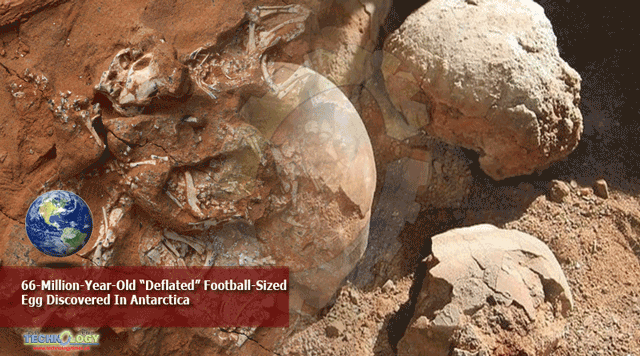An estimated 66 million years ago, an ancient marine reptile is believed to have left a large, football-sized egg on Antarctica.

It is the first known fossil soft-shell egg to have been left on the continent and perhaps laid by an ancient, extinct giant marine reptile known as a mosasaur.
“It is from an animal the size of a large dinosaur, but it is completely unlike a dinosaur egg,” said lead author Lucas Legendre, a postdoctoral researcher at the University of Texas Austin’s Jackson School of Geosciences,” in a statement. “It is most similar to the eggs of lizards and snakes, but it is from a truly giant relative of these animals.”
It was previously believed that giant marine reptiles from the Cretaceous did not lay eggs, yet “nothing like this has ever been discovered.” Chilean scientists first came across the fossil nearly a decade ago, after which it sat unlabeled in the country’s collections at the National Museum of Natural History. Scientists referred to the more than 28-by-18-centimeter (11-by-7 inches) stone-like fossil simply as “The Thing”.
Researchers pierced through the many layers of the egg’s membrane using microscopes to determine that the fossil was an egg. The “visibly collapsed and folded” thin-shelled egg is among the largest to have ever been described – second only to the elephant bird’s egg – and its structure is similar to most extant lizards and snakes, which is indicative of an ovoviviparous lifestyle whereby the egg develops inside of the mother and hatches immediately after being laid.
However, the egg had already hatched tens of millions of years ago, meaning whatever was once encased within it is long gone. Though it is not clear what species laid the large egg, the researchers then compiled data of 259 living reptiles in order to compare egg to body size, suggesting that the animal would have measured more than 6 meters (20 feet) long from end to end, not including a tail: it may have been a giant marine reptile known as a mosasaur or perhaps by a yet-to-be-determined dinosaur species. Regardless, it represents a new taxon: Antarcticoolithus bradyi.
“Such a large egg with a relatively thin eggshell may reflect derived constraints associated with body shape, reproductive investment linked with gigantism, and lepidosaurian viviparity, in which a ‘vestigial’ egg is laid and hatches immediately,” write the study authors in Nature.
Where the egg was found in the rock formation is also telling of the environment in which it hatched in. Nearby, skeletons of both baby and adult mosasaurs and plesiosaurs have been found, suggesting that this area may have been a “sort of nursery site” characterized by a protected cove environment.
It is also not clear how the animal hatched. It could be that the mother laid the egg in open water in the same way as modern sea snakes, or that the reptile wriggled its way onto the shore – it would have been too heavy to hold up its own body weight – and used its tail to create a nest of sorts before its hatchlings scurried out to sea like sea turtles today.
The findings have been published in collaboration with a second studydescribing how soft-shell eggs may have evolved over time.
originally posted at:https://www.iflscience.com/